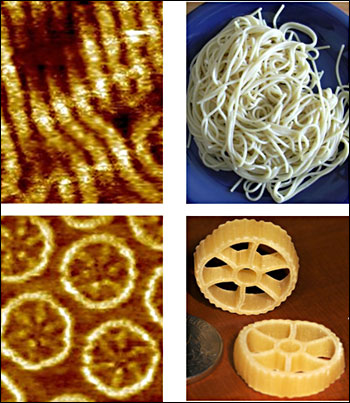
Well-rounded Molecules Make Better Light Emitters
The more well-rounded the organic molecule the better when it comes to maximizing light emission, an international team of physicists and chemists have found.
A team led by the University of Utah working to develop more efficient OLEDs believes it has solved a major problem with today’s LEDs: that much of the light is polarized in one direction and trapped within the diode. They discovered their new organic molecule — shaped like a wagon wheel — emits light randomly in all directions. Such a feature is necessary for a more efficient OLED; existing OLEDs now in some smartphones and TVs use spaghetti-shaped polymers that emit only polarized light.
The large rotelle pasta-shaped molecules also can “catch” other molecules and could make effective biological sensors; they also have potential use in solar cells and switches.

Images of molecules for LEDs on the left are compared with similar-shaped pasta on the right. The upper left electron microscope image shows spaghetti-shaped organic polymers now used for OLEDs. The lower left image shows new molecules — created by scientists at the University of Utah and two German universities — that are shaped like wagon-wheel or rotelle pasta and emit light more efficiently than the spaghetti-shape polymers. Images courtesy of Molecule images by Stefan Jester, University of Bonn. Pasta images courtesy of Wikimedia Commons.
“This work shows it is possible to scramble the polarization of light from OLEDs and thereby build displays where light doesn’t get trapped inside the OLED,” said University of Utah physicist John Lupton, lead author of a study of the “pi-conjugated spoked-wheel macrocycle” published online in Nature Chemistry.
“We made a molecule that is perfectly symmetrical, and that makes the light it generates perfectly random,” he said. “It can generate light more efficiently because it is scrambling the polarization. That holds promise for future OLEDs that would use less electricity and thus increase battery life for phones, and for OLED light bulbs that are more efficient and cheaper to operate.”
Lupton emphasizes the study is basic science, and new OLEDs based on the wheel-shaped molecules are “quite a way down the road.”
OLEDs now are used in smartphones, he said, particularly the Samsung Galaxy series; in pricey new superthin TVs being introduced by Sony, Samsung, LG and others; and in lighting.
“OLEDs in smartphones have caught on because they are somewhat more efficient than conventional liquid-crystal displays like those used in the iPhone,” he said. “That means longer battery life. Samsung has already demonstrated flexible, full-color OLED displays for future roll-up smartphones.” Such phones, he said, could produce light more efficiently using molecules that don’t trap as much light.
While conventional LEDs use silicon semiconductors, OLEDs in some of the latest cell phones and TVs are made with pi-conjugated polymers, plastic-like, organic semiconductors made of a chain of repeating molecular units.
“Conjugated polymers are a terrible mess,” Lupton said. “They now make only mediocre OLEDs, although people like to claim the opposite.”
For one thing, three-quarters of the light energy is in a state that normally is inaccessible — a problem addressed by another recent University of Utah study of OLEDs. Lupton says his study deals with another problem, which exists even if the other problem is overcome: the polarization of light in pi-conjugated polymers that leads to the trapping of up to 80 percent of the light generated.
“The rotelle — technically called oligomers — are basically wrapped-up polymers,” Lupton says. “They all have the same shape, but they do not emit polarized light because they are round. They generate waves that vibrate in all directions. The light doesn’t have a fixed polarization; it doesn’t vibrate in a fixed direction. It always can get out.”
Using the new oligomers instead of spaghetti-shaped polymers, “in principle, we should be able to double the efficiency of getting the light out” — although that remains to be proved, Lupton said.
“Even if we scramble the polarization, we’re always going to have a bit of light trapped in the OLED,” he said. “Those losses are now 80 percent, and we probably could get down to 50 or 60 percent.”
For more information, visit: www.utah.edu
Published: September 2013